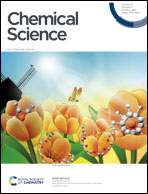Correlating axial and equatorial ligand field effects to the single-molecule magnet performances of a family of dysprosium bis-methanediide complexes†
Abstract
Treatment of the new methanediide–methanide complex [Dy(SCS)(SCSH)(THF)] (1Dy, SCS = {C(PPh2S)2}2−) with alkali metal alkyls and auxillary ethers produces the bis-methanediide complexes [Dy(SCS)2][Dy(SCS)2(K(DME)2)2] (2Dy), [Dy(SCS)2][Na(DME)3] (3Dy) and [Dy(SCS)2][K(2,2,2-cryptand)] (4Dy). For further comparisons, the bis-methanediide complex [Dy(NCN)2][K(DB18C6)(THF)(toluene)] (5Dy, NCN = {C(PPh2NSiMe3)2}2−, DB18C6 = dibenzo-18-crown-6 ether) was prepared. Magnetic susceptibility experiments reveal slow relaxation of the magnetisation for 2Dy–5Dy, with open magnetic hysteresis up to 14, 12, 15, and 12 K, respectively (∼14 Oe s−1). Fitting the alternating current magnetic susceptibility data for 2Dy–5Dy gives energy barriers to magnetic relaxation (Ueff) of 1069(129)/1160(21), 1015(32), 1109(70), and 757(39) K, respectively, thus 2Dy–4Dy join a privileged group of SMMs with Ueff values of ∼1000 K and greater with magnetic hysteresis at temperatures >10 K. These structurally similar Dy-components permit systematic correlation of the effects of axial and equatorial ligand fields on single-molecule magnet performance. For 2Dy–4Dy, the Dy-components can be grouped into 2Dy–cation/4Dy and 2Dy–anion/3Dy, where the former have almost linear C![[double bond, length as m-dash]](https://www.rsc.org/images/entities/char_e001.gif) Dy
Dy![[double bond, length as m-dash]](https://www.rsc.org/images/entities/char_e001.gif) C units with short average Dy
C units with short average Dy![[double bond, length as m-dash]](https://www.rsc.org/images/entities/char_e001.gif) C distances, and the latter have more bent C
C distances, and the latter have more bent C![[double bond, length as m-dash]](https://www.rsc.org/images/entities/char_e001.gif) Dy
Dy![[double bond, length as m-dash]](https://www.rsc.org/images/entities/char_e001.gif) C units with longer average Dy
C units with longer average Dy![[double bond, length as m-dash]](https://www.rsc.org/images/entities/char_e001.gif) C bonds. Both Ueff and hysteresis temperature are superior for the former pair compared to the latter pair as predicted, supporting the hypothesis that a more linear axial ligand field with shorter M–L distances produces enhanced SMM properties. Comparison with 5Dy demonstrates unusually clear-cut examples of: (i) weakening the equatorial ligand field results in enhancement of the SMM performance of a monometallic system; (ii) a positive correlation between Ueff barrier and axial linearity in structurally comparable systems.
C bonds. Both Ueff and hysteresis temperature are superior for the former pair compared to the latter pair as predicted, supporting the hypothesis that a more linear axial ligand field with shorter M–L distances produces enhanced SMM properties. Comparison with 5Dy demonstrates unusually clear-cut examples of: (i) weakening the equatorial ligand field results in enhancement of the SMM performance of a monometallic system; (ii) a positive correlation between Ueff barrier and axial linearity in structurally comparable systems.

- This article is part of the themed collection: Celebrating the 200th Anniversary of the University of Manchester


 Please wait while we load your content...
Please wait while we load your content...